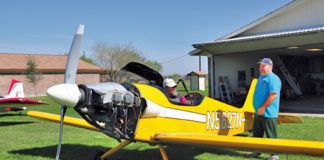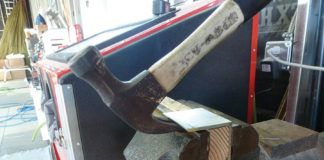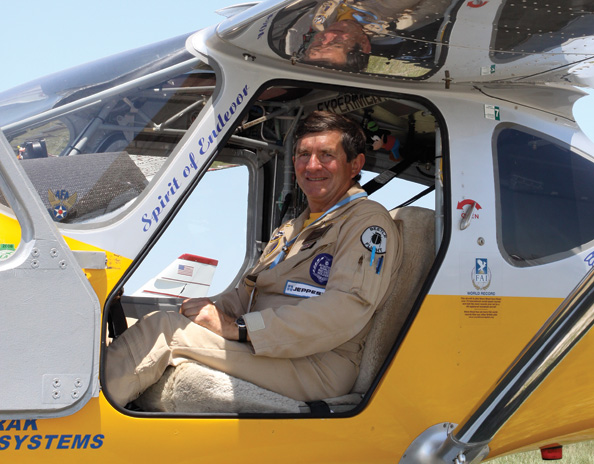
More than most people, pilots realize that outside forces can dictate diversions that often lead to new and rewarding destinations. Born just after WW-II, Steve Wood watched airplanes flying over his hometown of Harrogate, Yorkshire, roughly 200 miles north of London, and took a lifelong fancy to aviation. But his dream of flying professionally ended in 1964 at age 16, when he suffered a kidney stone, a disqualification under the U.K.s strict aeromedical requirements.
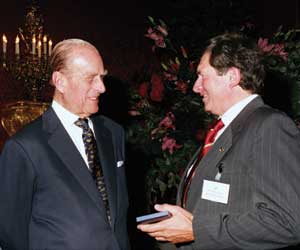
In 2008, HRH Prince Phillip presents Wood with the Scott-Farnie Medal, which recognizes work in the field of air education.
This diversion was the first of several that ultimately led him to set 377 speed records over recognized courses between May 2007 and April 2010, more than any other British pilot. Some 101 of them were world records verified by the Fdration Aronautique Internationale (FAI). He flew all of them in his handcrafted GlaStar, affectionately called Goofy for its U.S. registration, N600FY. Along the way he raised awareness for aviation programs that serve the young and disabled.
Pursuing a career that allowed him to look skyward, in 1978, at the minimum age, then 30-year-old Wood was elected a fellow of the Royal Institution of Chartered Surveyors. By that time he was a keen motorcyclist. (His current ride, an R1150GS, is the same color as his airplane-BMW yellow.) Seeing the benefit of the air ambulance that started serving London in 1989, Wood organized Heli-Aid in 1991 to urge the National Health Service to increase the service. Today, according to the Air Ambulance Association, 30 EMS helicopters cover the island nation.
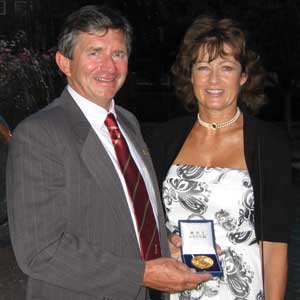
Wood and his wife, Belinda, enjoy the medal moment.
Wood founded and financed the GreenHawk Trust in 1998 to bring free flights to disabled, disadvantaged and life-limited children. The Trust flew more than a thousand kids before Wood and his wife, Belinda, now married 38 years, became bi-continental in 2001. GreenHawks inspiration came from the programs that motivated Woods record efforts: EAA Young Eagles, the U.K.s Flying Scholarships for the Disabled and its U.S. counterpart, Able Flight. Britains Air League recognized Woods air education efforts in June 2008, when Prince Phillip presented him with the Scott-Farnie Medal.
Having saved some money, in February 1993 Wood acted on his flying desires at a flight school in San Diego. I did all the bookwork and got myself well prepared before arriving for a well-planned month of flight training. As it happened, that first school wasn’t any good, he says, without going into details, so I got to finding another. When he started with San Diego Flight Training International, two weeks remained. I got the [private pilot] checkride on the day before I left; I got the long cross-country the previous day, he says without fanfare.
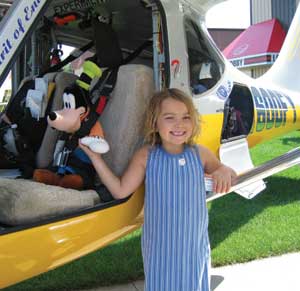
Everybody likes Goofy. This photo was taken prior to the start of the AirVenture Cup in 2008 after setting a record from Vancouver to Pierre, South Dakota.
The following year Wood visited New Zealand, where he earned another license because there was a chance to fly there professionally. That didn’t work out for his wife, he says with some regret. Afterwards, I really didn’t know what I wanted to do with flying, and given the restrictions and expense, he couldn’t justify it. That changed in 1996 when he decided to build an airplane and circumnavigate the globe in the name of his air-education interests.
Getting Goofy
Looking for a safe airplane with good speed and useful load that would be suitable for Young Eagle flights-and for flying around the world-Wood picked the GlaStar. The EAA was building one for its Young Eagle efforts, and the design offered choices that included floats and conventional gear. Wood got a good deal from the projects major players, Continental, MT Propellers and Glasair Aviation, before the kit arrived in 1997. An arrangement to build it at RAF Cosford, a maintenance-training base, fell through at the last moment. The RAF connection led Wood 150 miles south, to the Aero Engineering Department at Cambridge Regional College. At best, he worked on the airplane just two or three days a week for five years, and during that time the school used it to show students how an airplane is constructed, Wood said.
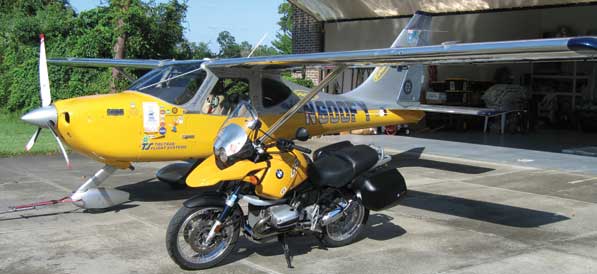
Woods BMW R1150GS and Goofy share the same paint scheme.
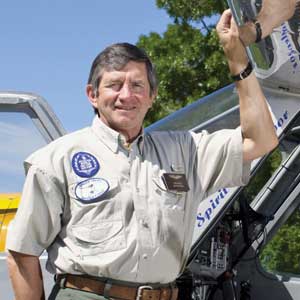
Wood has reason to be proud of what he and Goofy have accomplished.
In 2001, We decided we wanted somewhere in the sun, Wood recalled. Remembering a TV program about Spruce Creek, a residential airpark in Daytona Beach, Florida, they thought theyd visit and take a look. It became the couples second home, and the GlaStars primary residence that fall, and they travel back and forth three times a year.
With the help of the communitys EAA members, Goofy earned its airworthiness certificate on December 17, 2003, the centennial of powered flight. Wood named the plane shortly before that. I was looking for an interesting registration number, came across N600FY, and reserved it. Knowing his friends might rib him he debated using it, but in the end he thought, Why not? A large, plush Goofy toy accompanies him when he flies kids. Hes a bit timid, you know, Wood says. Ive got a little tiny one that flew with me on my world records.
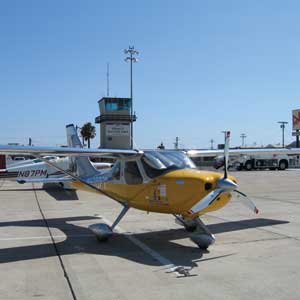
The GlaStar waited at Brown Field in San Diego before Wood began his West Coast record quest.
With the GlaStars standard setup of main and auxiliary tanks, the wings carry 50 gallons. Two 40-gallon bladders, one replacing the right seat and the other in baggage, would cover the 2100-nautical-mile leg between California and Hawaii. With a 120-knot cruise, the plan was to fly at an altitude that gave 6 gph. Depending on the wind, it would be an 18- to 20-hour leg. Human endurance? I really don’t seem to have a problem with that, Wood said. The plan was to put a tube to the outside.
The GlaStar is equipped for IFR with a Bendix/King KLN94 GPS and Blue Mountain G3 EFIS. And Wood wouldn’t be without his two-axis TruTrak autopilot, XM Weather and Grand Rapids Technologies EIS engine monitor. Empty, the airplane weighs 1400 pounds, and Wood set its maximum weight at 2100 pounds, which puts it in FAI Class C-1b, a landplane with a takeoff weight between 500 and 1000 kilograms (1102 and 2204 pounds).
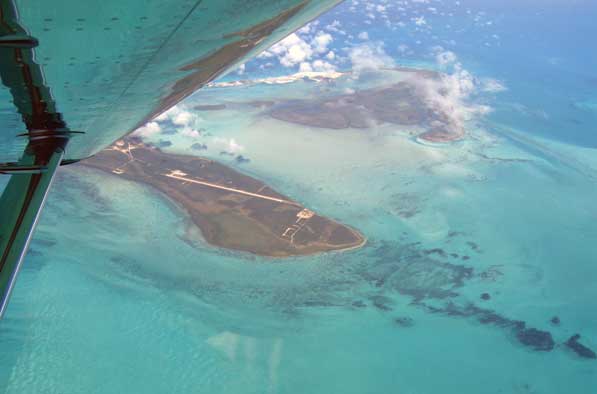
Wood turns toward Bimini after setting a record to that destination.
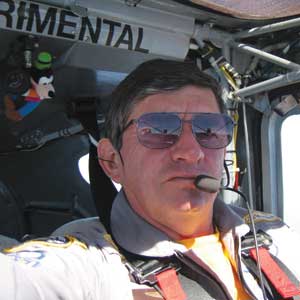
This self-portrait was taken at 11,000 feet above the Florida panhandle en route to the Bahamas.
Still planning the world flight, in 2005 Wood flew to Americas four corners, visiting EAA chapters, flying Young Eagles and arriving at Oshkosh with the AirVenture Cup Race. On his way to San Diego, Wood made a mid-afternoon pit stop at St. Johns, Arizona, elevation 5733 feet. With the OAT over 110 F, takeoff used most of the 5340-foot runway. With just 30 gallons on board, it wasn’t climbing very well, Wood said with a hint of understatement. Thinking of his world flight, he realized he needed a little bit more power if he was going to put the full weight on board.
Wood decided on the supercharged STi firewall-forward Subaru package so that he could use the boost to maintain normal sea-level manifold pressure to altitude, needing just 160 of the possible 210 horsepower at takeoff and 90 to 100 hp in cruise at altitude. After two years of planning, Wood took off around the world from AirVenture Oshkosh 2006. He made it to southern Ohio. A catastrophic engine failure (the second in 30 hours) put the airplane into a soybean field without a single smudge of green on its yellow skin.
Weighing his options, Wood mounted an Aero Sport Power IO-320 bought from his round-the-world savings, ending that effort. Never wavering from his air education mission, however, he asked himself, So what else can I do with the resources Ive got? Indirectly, Steve Fossett provided the answer. Obviously, he did some exceptional records, but a lot of his records are city-to-city distances. Having enjoyed his first four-corners flight immensely, Wood decided to repeat it for the record.
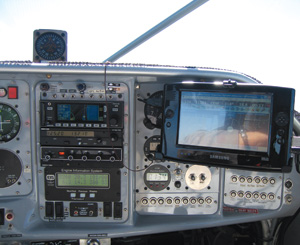
The GlaStars panel in its current state.
Marathon Man
Wood did not intend to set 377 records in less than three years. I was originally planning to set three or four records, a token, and promote the charity that way. Then, in May 2007, a weather window opened up between Orlando and London, Ontario, and through it came his first three world records. Looking forward to the four-corners flight, he decided, Well, Ill just keep setting records.
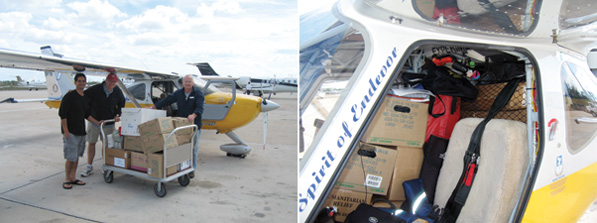
Left: The GlaStars useful load would be tested with the cargo for a Haiti relief flight. Right: The after photo, with the plane loaded.
Many pilots have the wrong idea about records, Wood says. The flying is relatively easy-the challenge is sorting out the paperwork…and the rules. First, pilots need an FAI sporting license, issued by the National Aeronautic Association (NAA) in America, the Aero Club of Canada or the U.K.s Royal Aero Club. Woods dual residency made this normally straightforward process complicated. In the end, what mattered, he says, was not his American license but his primary residence, Harrogate, so his sporting license came from the Royal Aero Club.
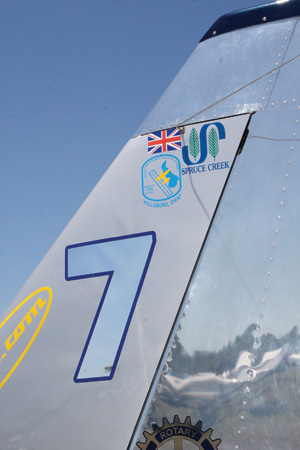
Lucky 7.
A record for speed over a recognized course can be flown between any two cities or geographical features designated for that purpose, which must be approved by that nations FAI representative, as well as the nation issuing the sporting license. Each end is identified by city, and each one often has a number of qualified start/finish airports, says Art Greenfield, NAAs director of contests and records. For example, the choices for Los Angeles include LAX, Van Nuys and Burbank.
The nation issuing the sporting license has to ratify the records initially, which is why Wood has 377 British national records. He decided to claim the most significant 101 international records as FAI world records. All of Woods world records are between the U.S. and Canadian or Bahamian cities. To set an international record, he explained, the course must cross an international border, which can get horrendously complicated.
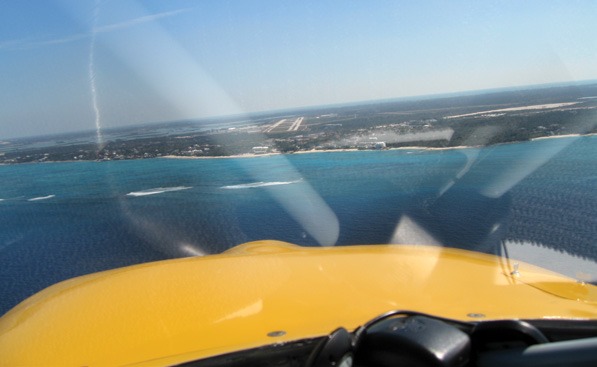
The view during a flight to help deliver supplies to Haitian earthquake victims.
Whether pursuing time-to-climb records or going for speed over a recognized course, pilots can set a number of records on the same flight. Cities within a nations borders must be at least 400 kilometers (250 miles) apart. Until 2008, there was no such requirement for international courses, which is how Wood set the world record for speed over the shortest recognized course, roughly the quarter mile between Windsor, Ontario, and Detroit.
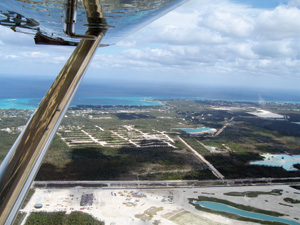
Another en-route view from the Haiti relief effort.
Setting it took two attempts because Wood didn’t fully understand the timing rules. The FAI accepts two timing methods, to which it applies a margin of error based on accuracy, he explained. One involves an official, an on-board time clock, and observers at both ends, all prohibitively expensive. No-cost start/finish times from ATC are less accurate, so they have a larger margin, one reason for the minimum distance requirement. The FAI said Woods May 2007 attempt was too fast for the timing used, so Wood had to use waypoints a bit farther apart. That made the timing work on the August 2007 do-over. (And in early 2008, the FAI put a 400-kilometer minimum distance on international courses. This retired 44 of Woods world records, ensuring that they will stand for all time.)
Wood files IFR for every record flight and, as part of his planning, telephones each ATC facility involved to explain his plans and what he needs. To minimize Goofys inconvenience to ATC in Southern Californias busy airspace, maintain a good speed and fly over the necessary waypoints, he negotiated a plan that started with an IFR departure from San Diego. Approaching Los Angeles, hed trade IFR for VFR flight following (to provide the needed timing), and work his way north and through the VFR corridor that passes directly over his Los Angeles waypoint, LAX. Naturally, the controller he checked in with didn’t know about this. But Wood was able to work it out on the fly, so to speak, because the controller read the flight plan comments, world record flight-need overhead and the list of airports.
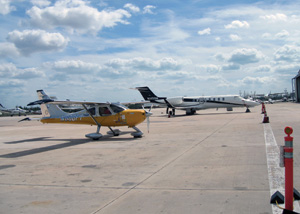
Goofy mixes it up with the big boys.
Vancouver Approach cleared Goofy for a 180 turn 2500 feet over Pitt Meadows, the Canadian finish for a dozen West Coast records. Wood avoided customs by landing at Bellingham, Washington. Almost an afterthought, he mentioned another aspect of timing: between start and finish, the clock never stops. On his long run east to Bangor, Maine, and Halifax, Nova Scotia, Wood stopped for a few hours in Duluth, the clock ticking while he slept. If you look at a lot of the old city-to-city records, some of them are at 10 mph, Wood says. FAI rules now require the record speed to be the faster of the airplanes stall speed or 100 km/h (62 mph).
Planning (and safely flying) a city-to-city record is no different from any other cross-country flight, Wood explained, but when pilots are on the clock, time zones become as important as the wind because daytime flights, though not required, are preferred. When the flight is over, then there’s the paperwork. Pilots have seven days to claim a record and 90 days to submit the supporting documentation. Obviously, I was flying, so I couldn’t chase them down, Wood said. A Spruce Creek neighbor, an NAA/FAI-approved observer, agreed to collect, collate, check and forward the necessary paperwork to the Royal Aero Club, which started the months-long ratification process that, in the case of world records, ends with the FAI.
Wood set 26 FAI world records on his 2007 flight around America that covered 10,019 miles in seven days and 70.6 hours. In November/December 2007 and April 2008 he set another 48 world records between American cities and the Bahamas. In July 2008 he set 13 more on his third four-corners tour, which started in the Bahamas.
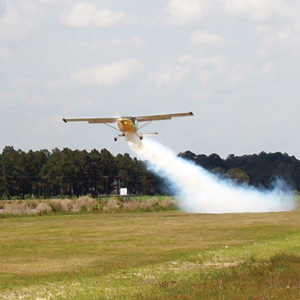
There’s more to life than just world record attempts. Here, Wood makes a rocket-assisted takeoff from Brent Maules grass strip at the Maule factory in Georgia. (Photo credit: Brent Maule)
In April 2010 Wood got around to thinking about setting some more FAI world records just to round it up to an even hundred. In fact he added another 11 FAI world records, bringing the total to 101 and in the process becoming the first pilot ever to set over 100 world records in a U.S.-registered homebuilt airplane. Im delighted to have set the records in a GlaStar,, Wood said. Its a superb airplane.
Wood occasionally thinks about flying around the world, but he says the problem now is the cost of doing it-and the availability of avgas; the only thing to do now is to fly with a diesel, because Jet A is universally available. At the moment, hes just enjoying flying and editing a free online aviation magazine (AV8Magazine.com).
Enjoyment with a Purpose
In February 2010 Goofy carried 350 pounds of medical and other supplies from North Carolina to Nassau, which was a staging area for post-earthquake relief for Haiti, followed by another flight from Fort Lauderdale to Nassau.
Wood also flies with Spruce Creeks gaggle flight group, which practices several times a week and serves the community. More recently, along with Retro Flight (they fly T-34s and are led by a rare Socata Epsilon), Wood flew a missing man formation flight for his friend Bill Lear Jr. It would have been Bills 82nd birthday, and his wedding anniversary Wood said. Retro Flight slowed down enough for me to keep up, Wood said, It was my great tribute to a great aviator.
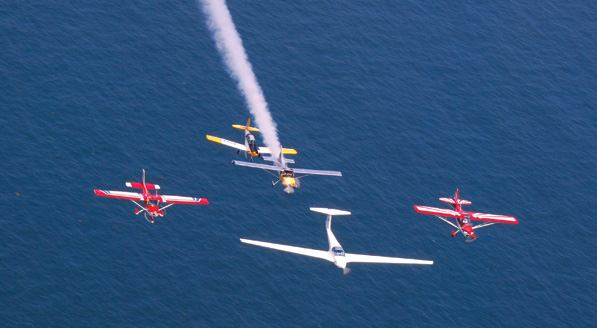
With the smoke on, Wood and Goofy had the opportunity to fly in formation with the Ximango motorglider. (Photo credit: Bob Roofman Terry).
For more information and a complete list of Woods records, visit http://records.fai.org/data?p=6298. Follow his exploits at www.fourcornersflight.org.










